Submitted by Berrin Chatzi Chousein
Dragon Buildings where Culture, Myths, and Traditions meet Architecture
China Architecture News - Feb 01, 2024 - 08:41 9380 views

Dragons are an important symbol of Chinese culture. In traditional beliefs, dragons represent power, auspicious powers, harvest and control over water. According to Chinese culture, the most popular among the twelve zodiac signs is the Dragon. In fact, it is believed that children born in the year of the dragon will be good leaders and very lucky in their life. The representations of dragons in Chinese culture are not limited to these, they are also believed to present "strength and valor, excellence and determination, dignity and divinity", according to a source, Chineasy.
So the basic questions to look for answers in architecture could be: how are these mystical beliefs reflected in today's Chinese architecture? why are so many modern buildings still designed with dragon-shapes or features? The reflection of dragons on Chinese architecture can be defined by many features; dragon-shapes, dragon-shaped patterns, or dragon motifs.
"Power and control" are the two most important symbols depicting the structures of Chinese architecture. That's why today's uses in contemporary architecture are also associated with cultural references and the context. The structure of dragons is depicted in a spiral position, with their heads turned to one side and their tails curled around a sphere. According to Chinese mythology, the sphere represents the celestial body that controls the tides, seasons and weather, while the dragon's presence on a building symbolizes "good luck and protection".
The forms of reflection in today's contemporary architecture appear as the shape of the dragon itself, references to the contextual parameters (e.g. rice fields, reservoirs, storms, floods), a painting depicting a dragon, or a performative façade element inspired by different dragons. Although these associations appear quite abstract, the form and language of architecture can become complex. While its contribution to the architectural context is debatable, many buildings cannot go beyond the embodiment of the iconic values of Chinese mythology on an urban scale.
"A dragon in China, as a culture, it's a spirit, it's a symbol," said Chen Yang, a professor of Chinese culture and philosophy at George Washington University. "The dragon is a well-known mascot. Throughout Chinese history, the dragon has represented good luck, justice, prosperity and strength," Yang added.
"People born in the year of the dragon are seen as charismatic, intelligent, confident, powerful, naturally lucky and gifted," Yang told Cincinnati.com I The Enquirer.
This year Chinese New Year will be celebrated on Saturday, February 10, 2024. According to Chinese belief, which says that 2024 will be the year of the Dragon, this means saying goodbye to the year of the Rabbit and hello to the year of the Dragon. As we prepare to celebrate Chinese New Year, we have compiled 10 of the most striking architectural projects in the world that symbolize the Dragon.
Read on for the 10 exemplary projects that represent or reference to Dragon (in no particular order):
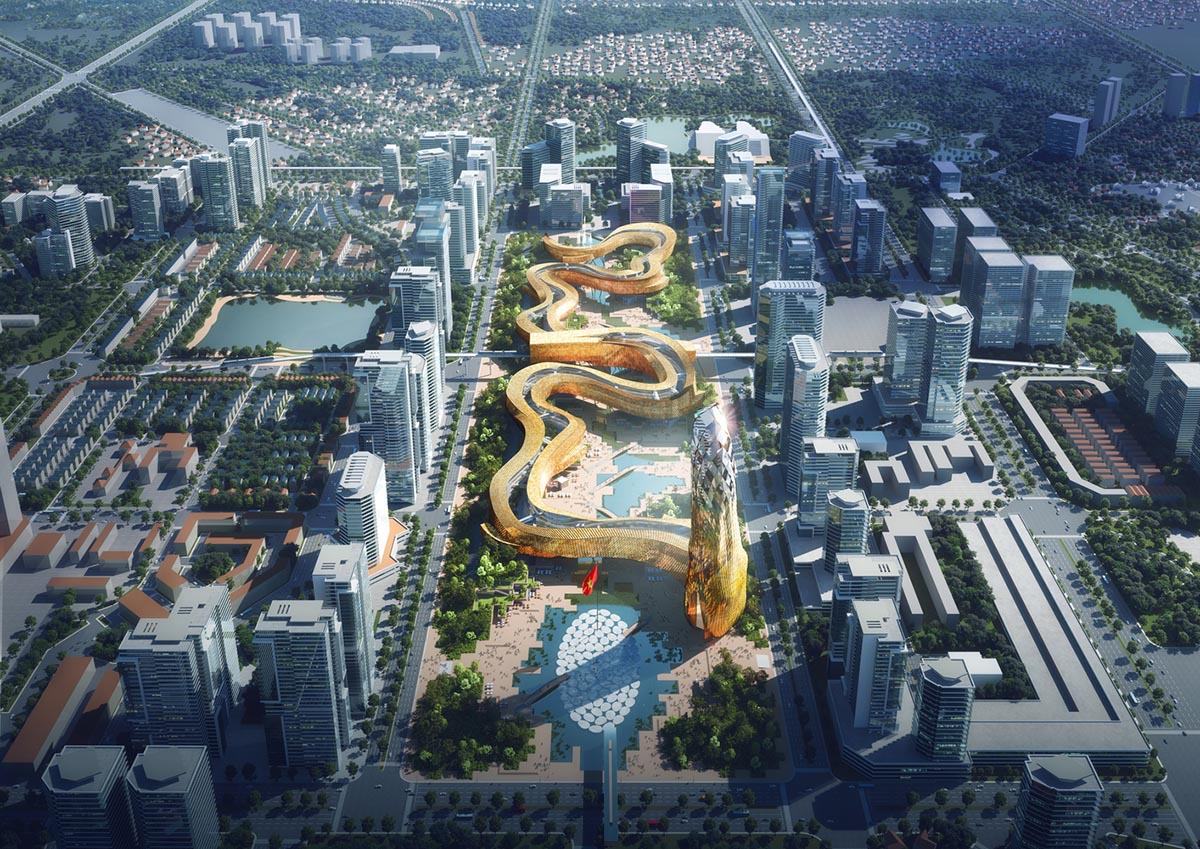
Dragon Tower by Dewan Architects + Engineers. Image courtesy of Dewan Architects + Engineers
Dragon Tower by Dewan Architects + Engineers, Hanoi, Vietnam, 2022
The Dragon Tower, designed by Dewan Architects + Engineers, represents the shape of a dragon.
The 700,000-square-metre mixed-use complex, as the firm explained, is "inspired by Sapa with stepped platforms as public spaces that will also serve as reservoir to control flooding by purposely flooding certain platforms in the rainy season and creating a live landscape that changes with the weather".
The design, which represents the dragon's head as a tower, represents the dragon's body in a spiral form with a volume that spreads horizontally. Lifted from the ground, the lower floors - where interaction between the public and the ministerial staff - are dedicated to the main lobbies and private meeting rooms, which do not require natural light. The building's complimentary functions for the staff, and the public, include nurseries, library, supermarket, restaurants, learning centers and others.
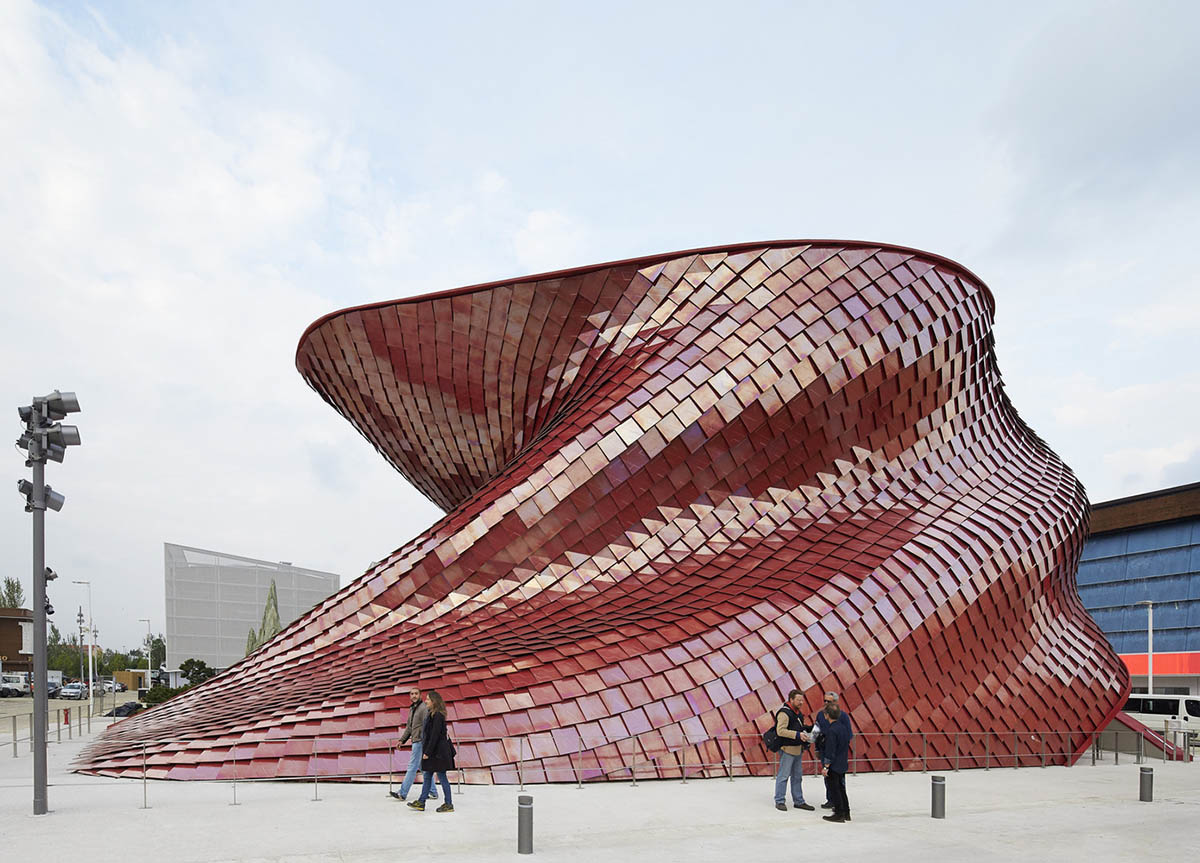
Vanke Pavilion by Libeskind Studio in Expo Milan 2015. Image © Hufton+Crow
Vanke Pavilion by Libeskind Studio, Milan, Italy, 2015
One of the most important examples of the dragons in façade design is the Vanke Pavilion designed by Daniel Libeskind's firm Studio Libeskind. The installation designed for Expo Milan 2015 reveals itself as a sculptural fragmentation with the red wings and their symbolism.
Inspired by traditional Chinese landscape painting, the structure represents rock formations, rice fields and prehistoric outcroppings. According to Libeskind, the pavilion "aims to tell the story of civilization, technology and the 21st Century as well as offer a space for reflection and celebration of different cultures."
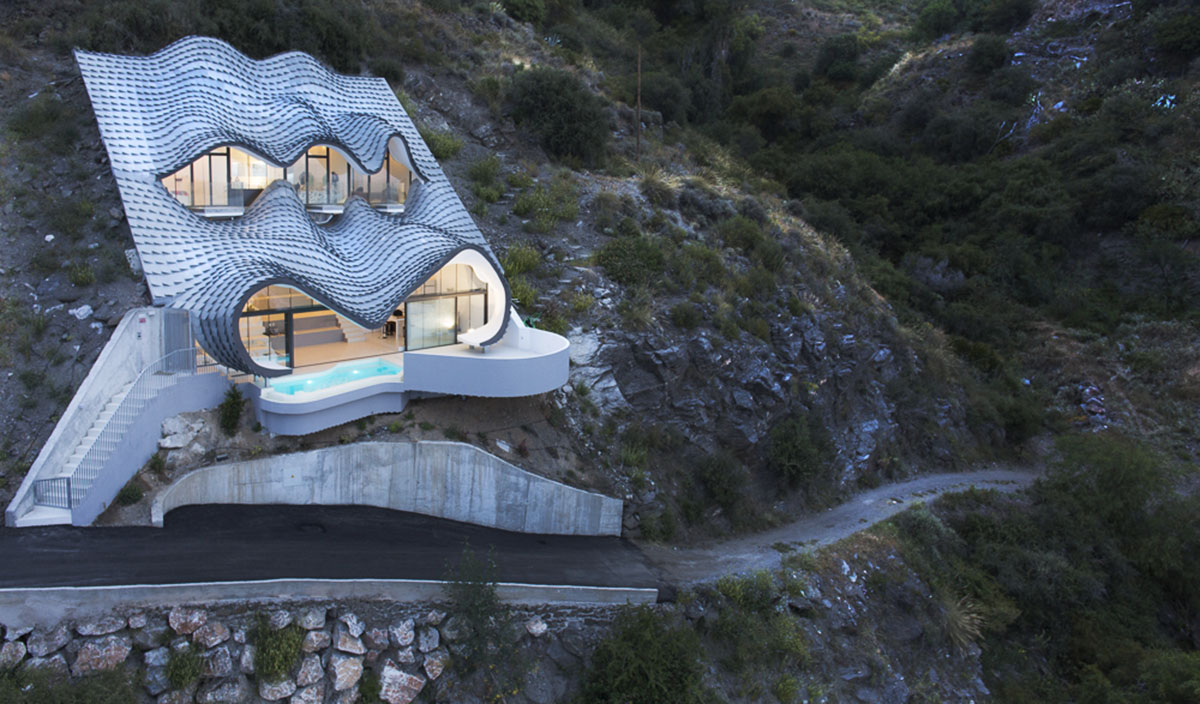
La Casa del Acantilado by GilBartolomé Architecture. Image © Jesus Granada
La Casa del Acantilado by GilBartolomé Architecture, Granada, Spain, 2015
Although it doesn't exactly resemble the shape of a dragon, this dragon-skinned residence designed by Madrid-based architecture firm GilBartolomé Architecture is dressed in a drag-shaped pattern.
A good example of performative dragon architecture, the project, named La Casa del Acantilado, is covered with wavy wire mesh zinc flakes and emerges as a reinterpretation of nature and innovation in the Mediterranean cliffs, near the magnificent Spanish city of Granada.
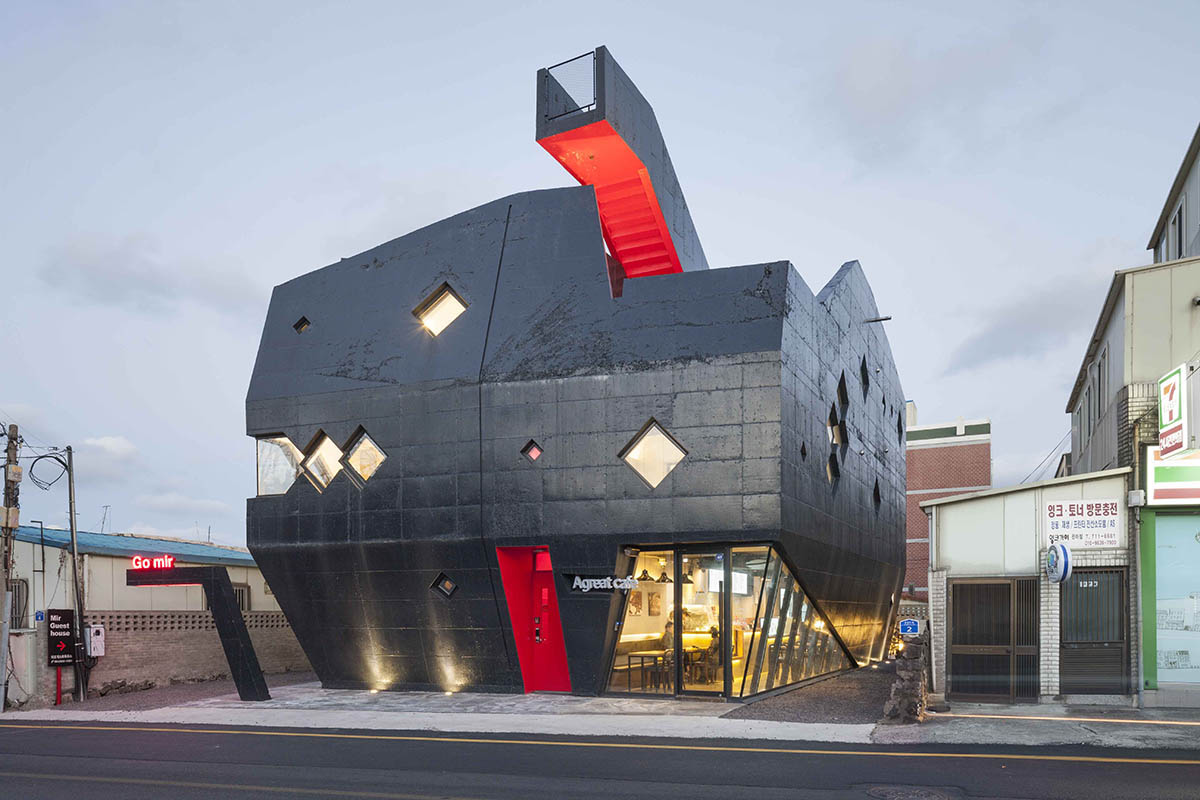
Go.Mir Guest House by MoonHoon. Image © Nam Goong Sun
Go.Mir Guest House by MoonHoon, Jeju-do, Korea, 2014
It is known that the impression of the Dragon has been seen in other countries besides China. Among these countries, Korea, Vietnam and Japan are the most well-known. In Korea, the architectural interpretation of the dragon is clearly seen in the Go.Mir Guest House designed by Korean architecture firm MoonHoon.
According to the architect "mir" means dragon in Korean...so Gomir means Go's dragon...Located on the famous resort island of Jeju, this guest house features two staircases arranged in a diagonal form, climbing upwards and offering guests the opportunity to observe. The most distinctive feature of the dragon appearance is the eurofoam coating with paint reminiscent of basalt rocks, rather than the form of the structure.
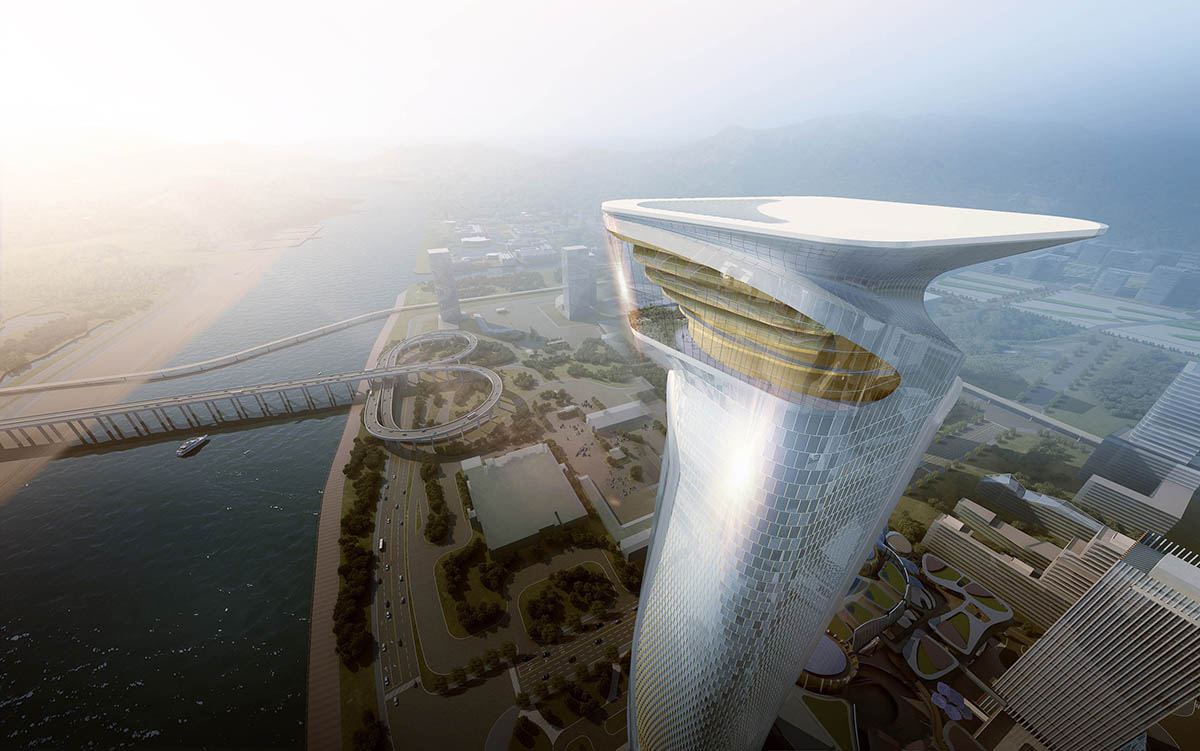
Hengqin MCC Headquarters Complex (Phase II) by Aedas. Image courtesy of Aedas
Hengqin MCC Headquarters Complex (Phase II) by Aedas, Zhuhai, China, 2019
Expected to be completed in 2025, the Hengqin MCC Headquarters Complex (Phase II) by Aedas is situated on a prime location on the Hengqin Island in Zhuhai, in close proximity to the Lotus Bridge that links to Cotai, Macau.
The 519,030-square-metre development features two high-rise office towers with a series of retail, banquet, entertainment and leisure venues. As the firm noted, the design of the towers is shaped around metaphorical attributions from dragons. "In ancient Chinese myths, the totem of two dragons chasing for a pearl symbolises good fortune and happiness. Design of the two towers and the small banquet building in between took reference from this totem," Aedas explained in its project description.
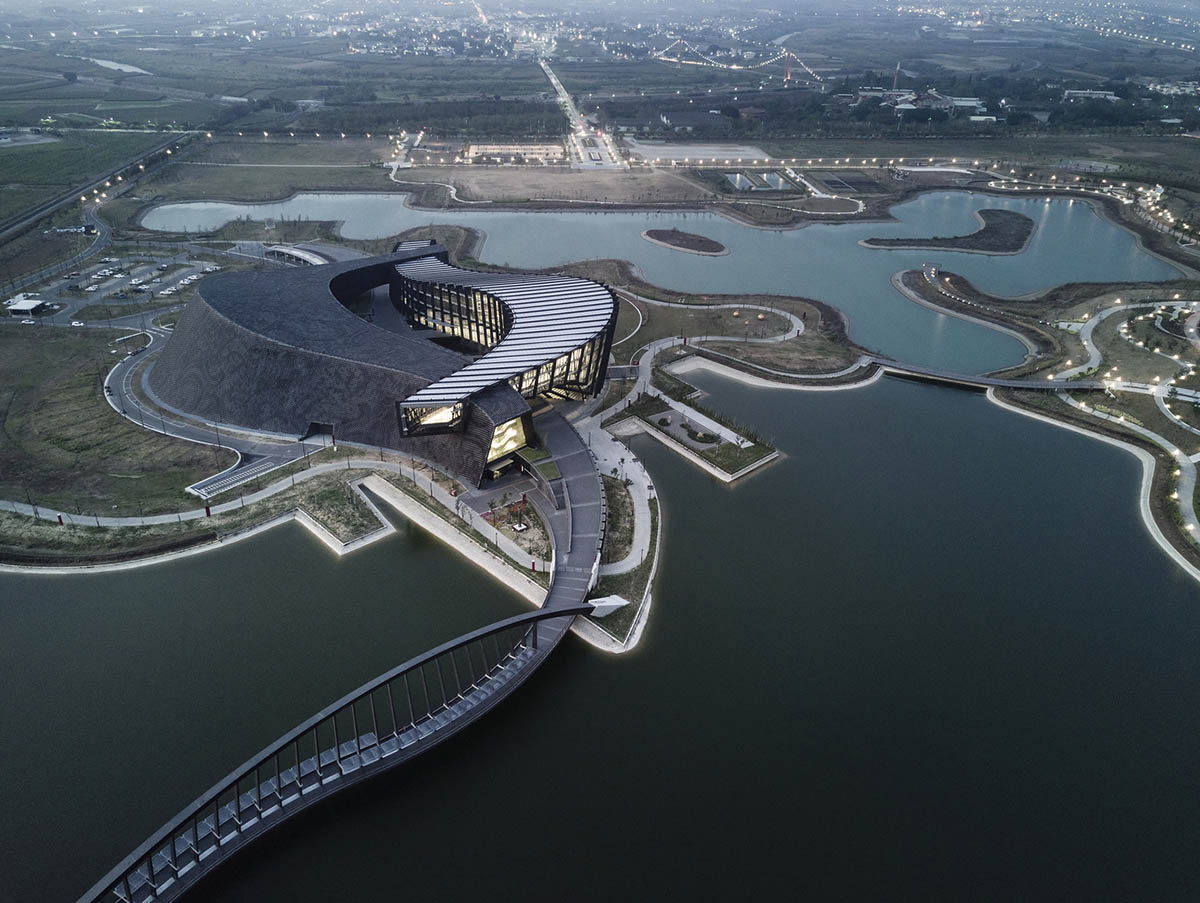
Southern Branch of Taiwan Palace Museum by KRIS YAO | ARTECH. Image © Shawn Liu Studio
Southern Branch of Taiwan Palace Museum by KRIS YAO | ARTECH, Taibao Cty, Taiwan, 2015
One of the two interlocking undulating volumes is covered with 36,000 cast aluminum discs, representing ancient bronze dragon and cloud patterns. Designed by KRIS YAO | ARTECH, the Southern Branch of Taiwan Palace Museum is located in the surrounding green rice and sugar cane fields, with its dark ink-colored skin and a sensuous sculptural form.
Combining three different volumes, the structure creates a unique facade, as the office describes, the reflection of the disks as the sun changes creates the illusion of a dragon "moving through the clouds."
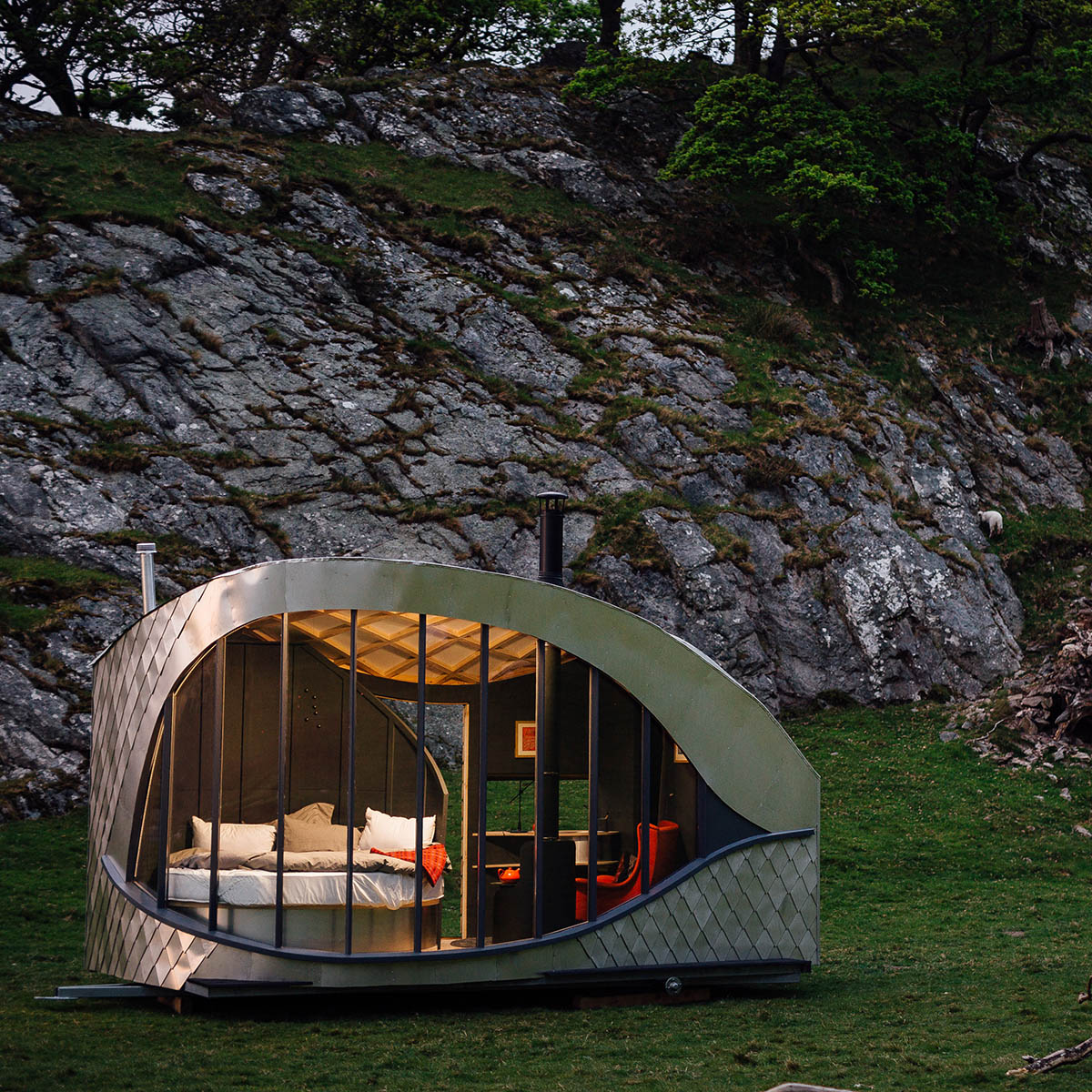
Dragon’s Eye by Clearly Carwyn Lloyd. Image via Wallpaper/press
Dragon’s Eye by Clearly Carwyn Lloyd, New Quay, West Wales, 2017
What undoubtedly makes this cabin epic is that it is designed in the shape of a dragon's single eye. The retreat cabin, designed by Carwyn Lloyd Jones in the form of a large eye, reflects the entire interior to the outside, especially at night, and is perceived from afar as an open eye.
The zinc and metal tiles evoke scales, while the cabin resembles the dragon in the Welsh Flag. The interior is like a magical cave with a bedroom, bathroom and living area.
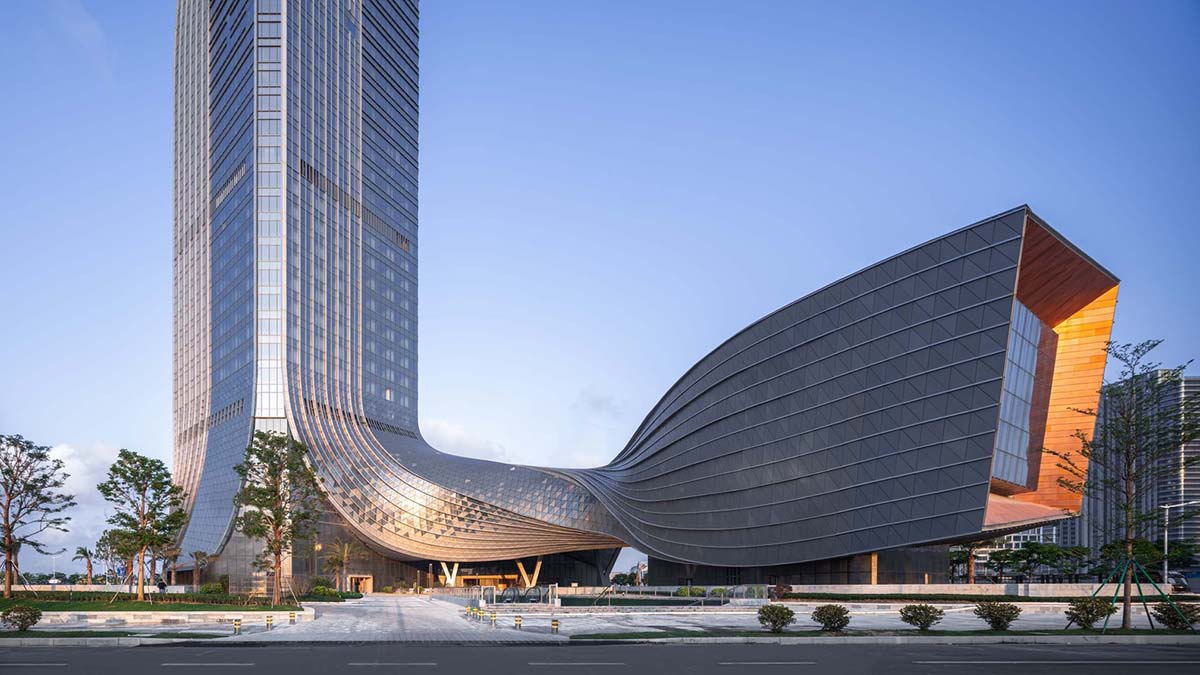
Hengqin International Financial Center by Aedas. Image by Aedas
Hengqin International Financial Center by Aedas, Zhuhai, China, 2020
Completed in 2020, Aedas-designed Hengqin International Financial Center, located in Zhuhai’s Hengqin Island, features a distinctive shape of a dragon with its spiral form. The 138,158-square-metre development is part of a future financial district connecting Hong Kong, Macao and other major cities in the Greater Bay Area. Conceived as a vertical complex, the design is "inspired by "The Nine Dragons", a famous stroll of Chinese painting from the Song Dynasty, the design embodies the convergence of energy in the architectural form," according to Aedas.
While the 4 blocks come together and rise to the sky as a single tower, the dragon head that bends and rotates downwards provides a smooth transition between the low podium and the vertical tower. Aedas achieves the low-ride podium "by pulling and bending the vertical elements around the central axis, transforming the tower walls into a podium roof."
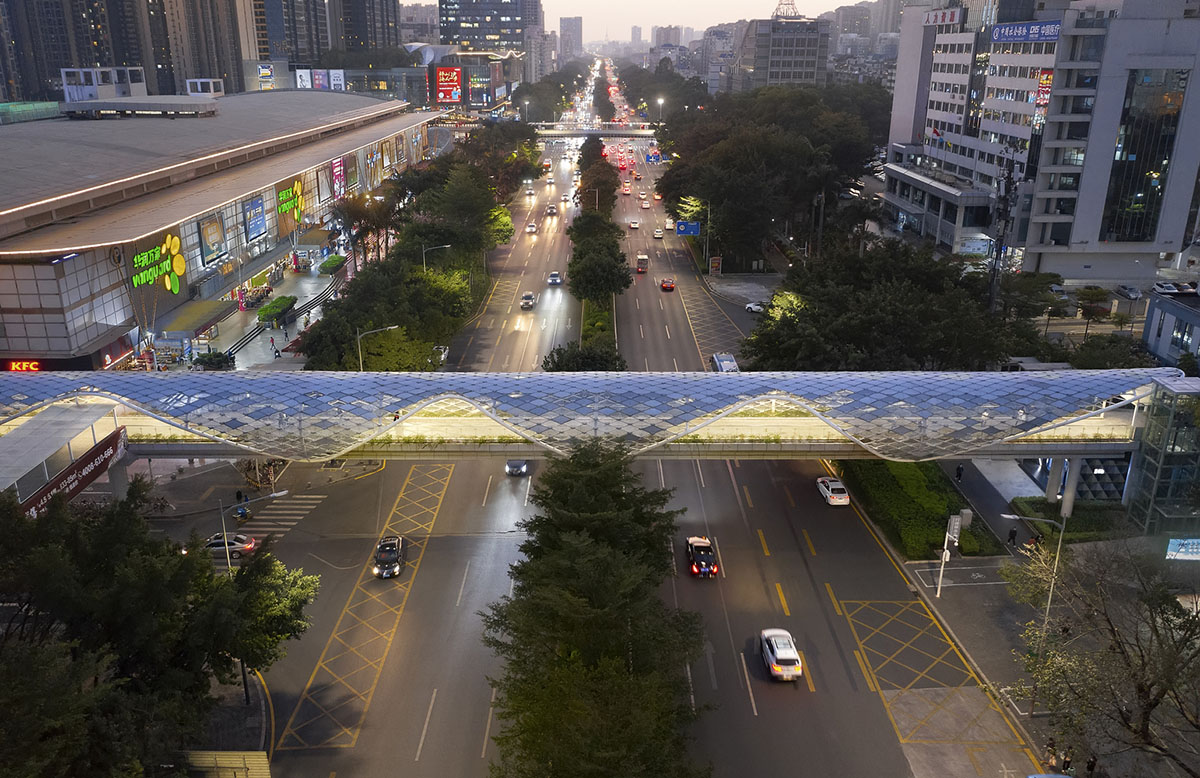
Longgang Core Area Overpasses Design by FCHA. Image © Tianpei Zeng
Longgang Core Area Overpasses Design by FCHA, Shenzhen, China, 2021
The bridge completed by FCHA emerges as a reflection of the Nine Dragon Painting. The bridge, formed by the combination of different steel modules, connects different points of Shenzhen in the third dimension. The project is described as nine "dragons" connecting the entire city.
The module design of the bridge is inspired by the traditional Chinese dragon dance art, while different positions of dragon-inspired overpasses are combined to create different types of streamlines.
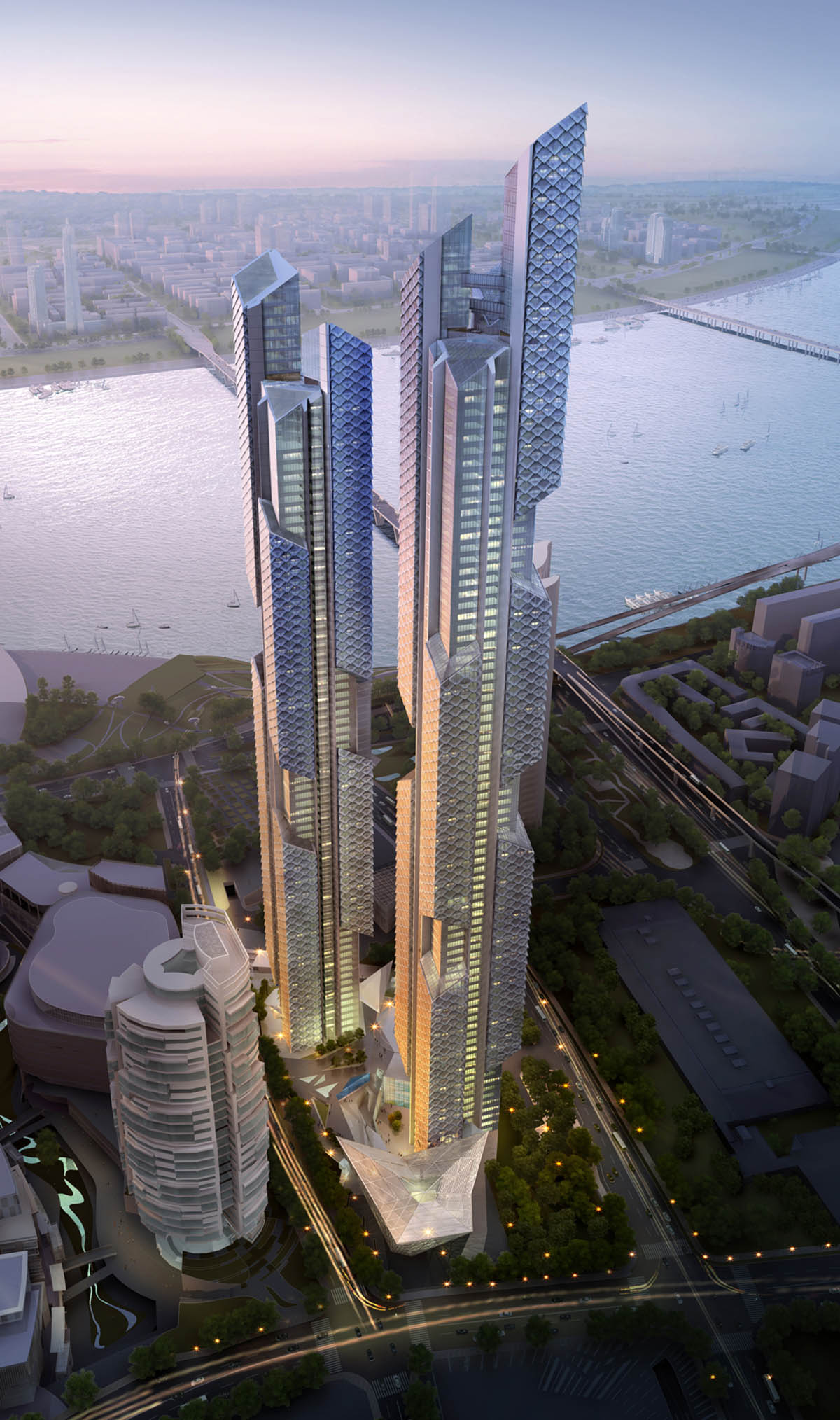
Dancing Dragons by Adrian Smith + Gordon Gill Architecture. Image courtesy of Adrian Smith + Gordon Gill Architecture
Dancing Dragons by Adrian Smith + Gordon Gill Architecture, Seoul, Korea, 2012
Beijing and Chicago-based architecture firm Adrian Smith + Gordon Gill Architecture proposed a pair of 450 metre-high landmark supertall mixed-use towers in Seoul. Proposed for the new Yongsan International Business District in Seoul, the overall architectural language of the towers is highly informed by the cultural references of traditional Korean culture.
The two Dancing Dragon towers consist of vertical mini-towers that are attached to the main core and feature a dramatic series of diagonal massing cuts. Throughout the towers, the mini-towers create living spaces that float beyond the structure. Details referencing the eaves of traditional Korean pagodas are extended onto the structure's exterior skin, evoking fish scales and Korean mythical creatures such as dragons that appear to dance around the core. While the project takes its name from these details, the name of the overall development is Yongsan, which means "Dragon Hill" in Korean.
Top image in the article: Dragon Tower by Dewan Architects + Engineers. Image courtesy of Dewan Architects + Engineers.
